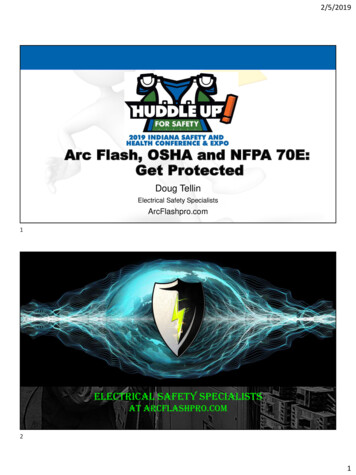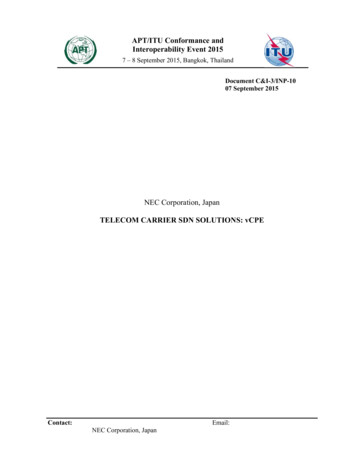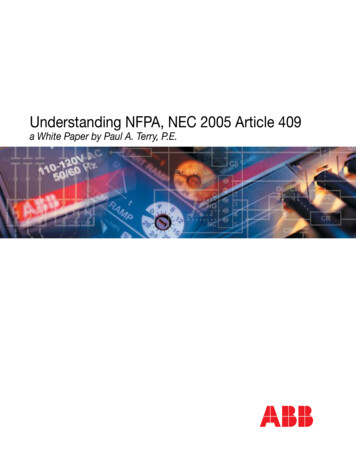
Transcription
Understanding NFPA, NEC 2005 Article 409a White Paper by Paul A. Terry, P.E.
Understanding NFPA, NEC 2005 Article 409NFPA 70, NEC 2005: Article 409Industrial Control Panel Short Circuit Panel RatingsExecutive SummaryMany panel shops are providing industrialcontrol panels with improper short circuitcurrent ratings or no short circuit currentratings at all. This creates a potentialfor accidental improper installation ofcontrol panels by trained installers, plusa possible fire and safety hazard. TheNational Fire Protection Association (NFPA)has implemented strict and very conciserules in the latest National Electric Code(NEC) to facilitate the safe design, marking,installation, and inspection of industrialcontrol panels (ICP).This white paper provides an overview ofthe following: The National Fire ProtectionAssociation’s jurisdiction and actions NEC changes that affect proper marking for industrial control panels (ICPs) Methods that can be used to ensure that an ICP is in compliance with the new code When the new NEC code will be enforced Examples that illustrate these topics and show how ICP’s should be marked to meet thenew NEC codeNFPA’s missionis to “reducethe worldwideburden of fire &other hazards.”IntroductionNEC 2005 has incorporated a brand new article, Article 409, to facilitate the safe design,marking, installation, and inspection of industrial control panels (ICP). The new articlecloses the loop and addresses areas of inconsistencies found in previous versions of theNational Electric Code (NEC).This paper will discuss brief background information regarding NFPA and NEC code, Article409, types of panels affected, enforcement timing, and methods that can be used to ensurepanels meet Article’s 409 short circuit marking requirements.Who is the NFPA?The National Fire Protection Association (NFPA) was established in 1896 and is a nonprofitorganization. The organization consists of more than 75,000 members representingapproximately 100 nations and over 300 employees around the world.Their mission is to “reduce the worldwide burden of fire and other hazards on the qualityof life by providing and advocating scientifically-based consensus codes and standards,research, training, and education.”The NFPA has developed 300 codes and standards that are intended to minimize thepossibility of and effects of fire and other risks. One of the most widely used NFPA electricalcodes is the National Electric Code (NEC), NFPA 70. The NEC code has evolved over time(since 1897) and is updated approximately every 3 years. Like any set of evolving “rules”,inconsistencies can develop within the code. The NFPA eventually identifies and correctsthese inconsistencies.NEC 2005 – Key Change Affecting the ICP IndustryIndustrial control panels are currently installed based on general requirements from variousNEC Articles. Because of inconsistent practice of installing equipment drawn from various White Paper by Paul. A. Terry, P.E.Compliments of ABB Inc., Wichita Falls, TX 888-385-1221
Understanding NFPA, NEC 2005 Article 409articles, NEC 2005 has been updated to address this issue. One of the key changes withinNEC 2005 is to focus on the safe design, application, and inspection of industrial controlpanels. The most influential change is the inclusion of Article 409 on – Industrial ControlPanels. Article 409 was added because of the increasing misapplication of ICP’s caused byinadequate short circuit ratings. Refer to Figure 1 to understand some of these conditionsand how the new requirement helps.The NEC defines and Industrial Control Panel as follows:“An assembly of a systematic and standard arrangement of two or more components suchas motor controllers, overload relays, fused disconnect switches and circuit breakers andHow this newrequirement helpsUnique ConditionIssueIndustrial control panels can bemoved around from installationto installation thus encounteringvarying electrical systems, environments, grounding means,and short-circuit current levels.Therefore, it is critical to supplythe ratings associated withthe industrial control panel assembly via markings in order toinsure a safe installation.These markings help the installer understand the equipment’sratings to ensure a safe installation. They allow comparisonof the equipments ratings withthe location’s maximum shortcircuit current.Many industrial control panelsare constructed by a manufacturer and installed by someoneelse.Without an exchange of information between the installerand manufacturer, any specialrequirements associated withthe panel will not be known bythe installer and possiblly causean unsafe installation.These new requirementsensure a proper exchange ofinformation through equipmentmarkings.Many industrial control panelsare field assembled and not assembled according to a productstandard.Compliance of field assembledcontrol panels is a complexprocess.Often unsafe installations aredue to:* Assemblers confused overwhat rule applies (NEC,NFPA79,etc.* AHJ’s not able to meet reviewdemand* MiscommunicationThe new short circuit currentrating marking requirementensures that field assembledpanels where product standards are not used, are properlymarked and lessens the burdenon AHJs to ensure compliancewith 110.10.There are an increasing numberand variety of components,devices and equipment being used in industrial controlpanels.The increasing amount ofinformation needed for safe application is difficult to manageleading to accidental unsafeinstallations.These new marking requirements will ensure that cricial information needed for the properapplication of the components,devices and equipment beingused in industrial control panelswill be provided.Fig. 1 - Benefits associated with inclusion of Article 409IAEI’s, January/February 2005, Short-Circuit Current Rating Requirements Facilitate compliance with 110.10, used by permission ofIAEI News.The main goalof Article 409 isto ensure thatall ICP’s aremarked with aproper shortcircuit currentrating.Compliance offield assembledcontrol panels isa complexprocess.related control devices such as pushbutton stations, selector switches, timers, switches,control relays, and the like with associated wiring, terminal blocks, pilot lights, and similarcomponents. The industrial control panel does not include the controlled equipment”Industrial control panels are also specified as assemblies rated 600V or less.The main goal of the new article is to ensure that all ICP’s are marked with a propershort circuit current rating. Properly listed short circuit current ratings allow the safeinstallation and relocation of ICP’s within the intended location. The article addressesgeneral requirements for all industrial control products. In addition to Article 409, all otherappropriate articles relating to the construction and installation of ICP’s used in specificWhite Paper by Paul. A. Terry, P.E.Compliments of ABB Inc., Wichita Falls, TX 888-385-1221
Understanding NFPA, NEC 2005 Article 409applications such as Article 430 (Motors, Motor Circuits, and Controllers), Article 440(AC and Refrigeration Equipment), Article 620 (Elevators, Escalators, etc), and Article 670(Industrial Machinery) still must be referenced and followed in order to complete the coderequirements.What is Meant by Short Circuit Rating?It is important to note that Article 409 addresses field and factory assembled controlpanels. This implies short circuit ratings for an entire assembly not just the rating of the mainovercurrent protective device. By assembly, we mean all components contained within anenclosure.The short circuit current rating of a component or equipment represents the maximum shortcircuit current level the device or equipment can safely withstand without compromisingsafety for buildings and personnel.Withstandratings & interrupt ratingsshould not beconfused.It is noteworthy to mention that withstand ratings and interrupt ratings should not beconfused. Interrupt ratings are ratings associated with overcurrent protective devices, suchas fuses or circuit breakers, and is referred to the ability of the overcurrent protective deviceto safely interrupt a short circuit at the specified marked interrupt rating. One should notassume that the interrupt rating of the overcurrent protective device represents the shortcircuit rating of the assembly. In fact, in most cases where many control components areused in the control panel (disregarding tested starter assemblies), the assembly short circuitrating will likely be less than the overcurrent protective device interrupt rating.How is the Assembly Short Circuit Rating Determined?Article 409.110 (3) clearly summarizes how the short circuit rating of an ICP is to bedetermined. According to 409.110, the short circuit current rating of an ICP must be basedon one of the following methods:1. Short circuit current rating of a listed and labeled assembly2. Short circuit current rating established utilizing an approved method(Note: UL508A-2001, Supplement SB, is an example of an approved method)The use of method one above may fair well with OEM equipment that has a fixed andconsistent design but does not fair well for panel shops where every panel will likely bedifferent. Once an overall assembly has been tested, one small change in the designrequires the panel to be retested. Since most panel shops build unique panels to meet acustomer specific requirement, method one would be time consuming and cost prohibitivefor most panel builders.Therefore, method two is typically the method of choice for determining an ICP short circuitcurrent rating.What is UL 508A-2001, Supplement SB? 1UL508A-2001, Supplement SB is one approved method for determining an ICP short circuitcurrent rating. Supplement SB contains the following instructions for determining the shortcircuit rating:Step 1: Determine the short circuit current rating of individual power circuitcomponents by using one of the following methods:A. Use the short circuit current rating marked on the component or onthe instructions provided with the component.B. For unmarked components, use the assumed short circuit currentrating from Table SB4.1 (see below) of Supplement SB.C. Use the tested short circuit current rating from a combination ofcomponents or component from UL508A1 Summarized from UL508A, used by permission of UL White Paper by Paul. A. Terry, P.E.Compliments of ABB Inc., Wichita Falls, TX 888-385-1221
Understanding NFPA, NEC 2005 Article 409Step 2:Step 3:When current limiting components are included within a portion of acircuit in the panel, modify the available short circuit current based onthe let-through values of the current limiting device.Determine the overall panel short circuit current rating according toSB4.4 of Supplement SB.Note: All power circuit components must have a short circuit currentrating (expressed in amperes or kilo-amperes and voltage) except thefollowing:Components exempt from short circuit current ratings:1. Power Transformers2. Reactors3. Current Transformers4. Dry-type Capacitors5. Resistors6. Varistors7. VoltmetersComponentShort circuitcurrent rating,kABus barsCircuit breaker (including GFCI type)Current metersCurrent shuntFuseholderIndustrial control equipmenta. Auxiliary devices (overload relay)b. Switches (other than mercury tube type)c. Mercury tube switches Rated over 60 A or over 250 V Rated 250 V or less, 60 A or less, and over 2kVA Rated 250 volts or less and 2kVA or lessMotor controller, rated in horsepower (kW)a. 0-50 (0-37.3)b. 51-200 (38-149)c. 201-400 (150-298)d. 401-600 (299-447)e. 601-900 (448-671)f. 901-1500 (672-1193)Meter socket baseMiniature or miscellaneous fuseReceptacle (GFCI type)Receptacle (other than GFCI type)Supplementary protectorSwitch unitTerminal block or power distribution 0a. A short circuit current rating is not required when connected via a current transformer or current shunt. A directly connectedcurrent meter shall have a marked short circuit current rating.b. The use of a miniature fuse is limited to 125 volt circuits.c. Standard fault current rating for motor controller rated within specified horsepower range.Table SB4.1 - Assumed maximum SSCR for unmarked components(Note: Reference only – refer to UL508A Supplement SB for determining SSCR’s)The steps above are very generalized and can become very complicated depending on thecomplexity of the industrial control panel. The goal of this paper is to simply provide a basicunderstanding of the concept. Contact the factory to obtain short circuit current ratings forICP’s of interest. A couple of basic examples have been included below to help illustratesome of the basic concepts.White Paper by Paul. A. Terry, P.E.Compliments of ABB Inc., Wichita Falls, TX 888-385-1221
Understanding NFPA, NEC 2005 Article 409Example #1 – ICP Rating for Untested CombinationsThis example illustrates how an ICP must be marked for a simple combination motor starter(20HP at 480V) where the circuit breaker/motor starter has not been short circuit tested asa combination. This particular example uses the assumed short circuit current rating for thecontactor/overload from UL 508A Table SB4.1 from Supplement SB.For unmarkedcomponents,use UL508A,Table SB4.1 forassumed SCCRvalues.Since the circuit breaker and starter combination has not been tested together for a shortcircuit current rating, we must use Step 1: A and B & Step 3 only from “What is UL 508A2001, Supplement SB?” above. We cannot use Step 1: C.The first step is to determine each individual component short circuit current rating. Theratings for this example are shown in Figure 2 below. The next step is to determine the lowestS1N050TLInterrupt rating 20kAA26-30-10-84 & TA25DU32(Assumed SCCR 5kA fromTable SB4.1 of UL508A)Required ICP Marking: 5kAFig.2 - Example #1,Industrial Control Panelshort circuit current rating of the lowest rated component. In this particular case, 5kA is thesmallest short circuit current rating. The industrial control panel must be marked with thelowest rated component: 5kA.Combinationtested components canincrease theICP’s SCCR. White Paper by Paul. A. Terry, P.E.Compliments of ABB Inc., Wichita Falls, TX 888-385-1221
Understanding NFPA, NEC 2005 Article 409Example #2 – ICP Rating for Tested CombinationsThis example illustrates how an ICP can be marked for a simple combination motor starter(20HP at 480V as before) where the circuit breaker/motor starter has been tested as acombination.Since the circuit breaker and starter combination have been tested together for a shortcircuit current rating, we can use Step 1: C & Step 3 from “What is UL 508A-2001,Supplement SB?” above.ABB has tested the A26 contactor with a S3 100A circuit breaker as a combination. Thistested combination has a 35 kA rating. Remember, these components have been stringentlytested as a set of combination components by UL.Combinationtested:35kA{OEMs & panelshops shouldcheck theirjurisdictions forcurrent coderequirements.S3L100MWInterrupt rating 65kAA26-30-10-84 & TA25DU32(Assumed SCCR 5kA fromTable SB4.1 of UL508A)Required ICP Marking: 35kAFig.3 - Example #2,Industrial Control PanelSince the only component in this example is the combination starter and it has been testedas a combination, the ICP can be rated 35kA. By using a tested combination, the ICP shortcircuit current rating has been significantly increased.When will NEC 2005 be Enforced?NEC 2005 is effective January 1, 2005 for jurisdictions that immediately adopt this versionof the code. Currently, there are 25 states that have implemented Article 409. It is veryimportant that all OEM’s and panel builders in the industry are made aware of the new coderequirements. The OEM and panel builder should check the existing code requirements fortheir jurisdiction to determine the enforcement of the new article.UL beginsenforcementApril 1, 2006Underwriters Laboratory (UL) will begin enforcing the new requirements associated withArticle 409 by April 2006.ConclusionIndustrial control panels must be supplied withthe proper short circuit current ratings to ensurepanels are safely installed. Proper marking allowsthe installer to positively identify if the location’savailable short circuit current ratings could exceedthe panels safe design limits. The goal is to ensurepanels are designed to maximize equipment andpersonnel safety and to reduce the risk of fires. Byfollowing the basic guidelines within the specifiedSSCR MarkingWhite Paper by Paul. A. Terry, P.E.Compliments of ABB Inc., Wichita Falls, TX 888-385-1221Fig.4 - Sample label
Publication No. LV0461SXU 000 046 G0201Printed in USA, March, 2006time period presented in this paper, panels shops can be certain to provide safe, reliable, and code compliant products.ABB demonstrated it’s industry leadership by implementing the new NEC code requirements a full year in advance of UL’starget date. Processes and procedures are implemented to include short circuit current ratings on all enclosed controlpanels (see illustration).ABB Inc.1206 Hatton RoadWichita Falls, TX 76302Telephone 888-385-1221; 940-397-7000Fax 940-397-7085http://www.abb-control.com
Understanding NFPA, NEC 2005 Article 409 articles, NEC 2005 has been updated to address this issue. One of the key changes within NEC 2005 is to focus on the safe design, application, and inspection of industrial control panels. The most influential change is the inclusion of Article 409 on - Industrial Control Panels.
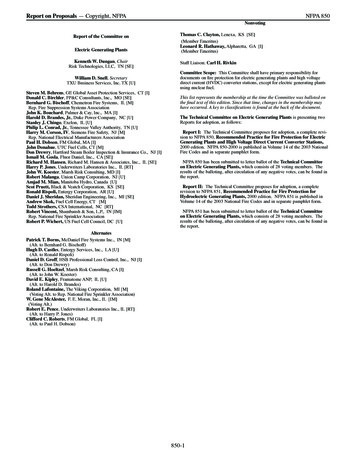

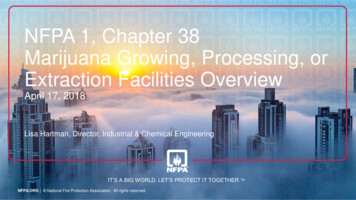
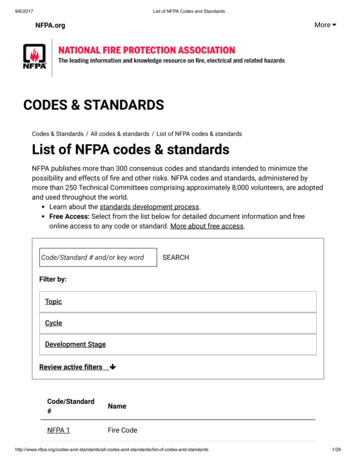
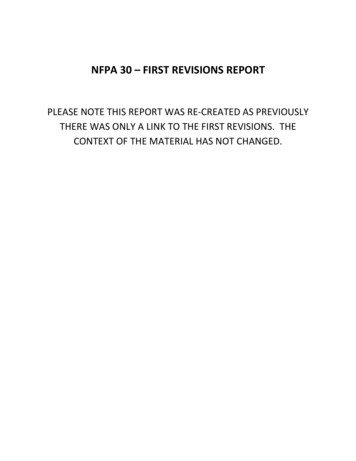
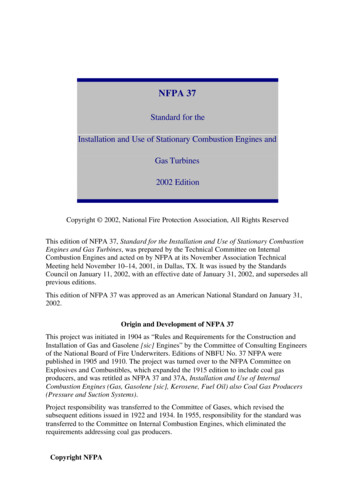
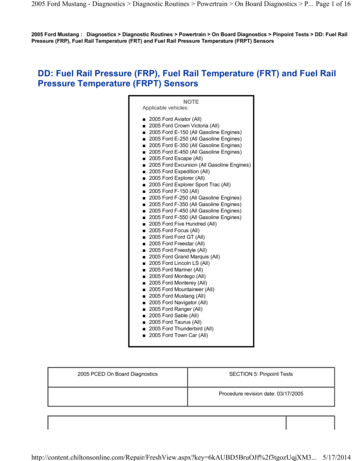
![First Revision No. 8978-NFPA 70-2018 [ Global Input ]](/img/38/70-a2020-nec-p07-fd-frstatements.jpg)
